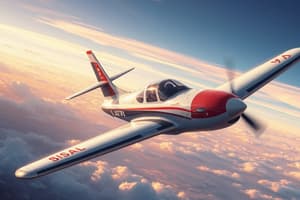Podcast
Questions and Answers
What is the required vertical speed during final approach under normal conditions?
What is the required vertical speed during final approach under normal conditions?
Which parameter must be maintained at or below 15 degrees during final approach?
Which parameter must be maintained at or below 15 degrees during final approach?
What action should the flight crew take if any parameters are exceeded after passing 1,000 ft HAA?
What action should the flight crew take if any parameters are exceeded after passing 1,000 ft HAA?
What is the recommended speed range before landing?
What is the recommended speed range before landing?
Signup and view all the answers
What must the aircraft configuration be during the final approach?
What must the aircraft configuration be during the final approach?
Signup and view all the answers
What does a flight crew member need to do upon observing a parameter exceedance?
What does a flight crew member need to do upon observing a parameter exceedance?
Signup and view all the answers
What constitutes a go-around according to the operations manual?
What constitutes a go-around according to the operations manual?
Signup and view all the answers
What is the purpose of the Minimum Equipment List (MEL) in this context?
What is the purpose of the Minimum Equipment List (MEL) in this context?
Signup and view all the answers
Study Notes
Aircraft Stabilization on Final Approach
- At or below 1,000 ft Height Above Airport (HAA) in both IMC (Instrument Meteorological Conditions) and VMC (Visual Meteorological Conditions), specific parameters must be established.
- Speed must be maintained between Vref and Vref+20 to ensure a safe approach.
- Vertical speed must be less than approximately 1,000 ft/min; if exceeding this rate, a special briefing is mandatory.
- Bank angle should be 15 degrees or less to maintain stability during landing.
- Thrust must be above idle to ensure adequate power for landing.
- Aircraft must be in the intended landing configuration for optimal performance.
- Position should allow landing within the runway’s touchdown zone using normal maneuvers.
- All briefings and checklists must be completed prior to landing.
Go-Around Procedure
- If any parameters are exceeded while passing 1,000 ft HAA or before reaching 50 ft, a go-around is required.
- A flight crew member noticing parameter exceedance must notify the Pilot Flying (PF) to initiate a go-around.
- An immediate missed approach is the required response to a "GO-AROUND" alert.
- AEROTRANSCARGO management supports the crew's decision to discontinue the approach for safety reasons.
- Any missed approach must be reported through the CENTRIK system.
Extended Twin Operations (ETOPS)
- ETOPS regulations do not apply to AEROTRANSCARGO operations.
Use of Minimum Equipment and Configuration Deviation Lists
- Unserviceable items of installed aircraft equipment may not impact the aircraft's safety or operational fitness for flights.
- AEROTRANSCARGO holds CAA RM approval permitting operations with certain unserviceable items, following the Minimum Equipment List (MEL).
- The MEL must align with the Master MEL (MMEL), which is established by the aircraft manufacturer and sanctioned by the Type Certificating Authority.
Studying That Suits You
Use AI to generate personalized quizzes and flashcards to suit your learning preferences.
Related Documents
Description
This quiz focuses on the key procedures for aircraft stabilization during final approach as outlined in Chapter 8 of the Operations Manual. Participants will review critical parameters such as speed and vertical speed required for safe operations in IMC and VMC conditions.




